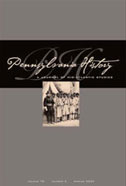Sanctified Landscape: Writers, Artists, and the Hudson River Valley, 1820–1909 by David Schuyler
Main Article Content
Abstract
Seen from a car passing over the Tappan Zee Bridge or an overlook in one of the towns that hug its shores, the Hudson River presents a deceptive sense of calm and timelessness. It is an essential part of the furniture of American history, providing a reliable scaffolding for episodes that are often recalled dutifully, if a bit dimly: the Revolutionary War, the invented knickerbocker history of Washington Irving, and the group of nineteenth-century artists now known as the Hudson River School. David Schuyler's book, a study of the literary and visual culture created by an elite group of writers, artists, and other tastemakers in the Hudson Valley between 1820 and 1909, helps overturn that deathless and static image. His book bristles with odd and surprising details that make clear how intensely human activity shaped those landscapes. Irving's cottage in Tarrytown, New York, for instance, boasted a lake in the shape of the Mediterranean and a "vaguely Spanish" pagoda (53). Just as telling is Irving's indignant reaction as his "snuggery" was invaded by the "infernal alarum" of a railway line (56).
Article Details
Section
Book Reviews
Pennsylvania History is the official journal of the Pennsylvania Historical Association, and copyright remains with PHA as the publisher of this journal.
